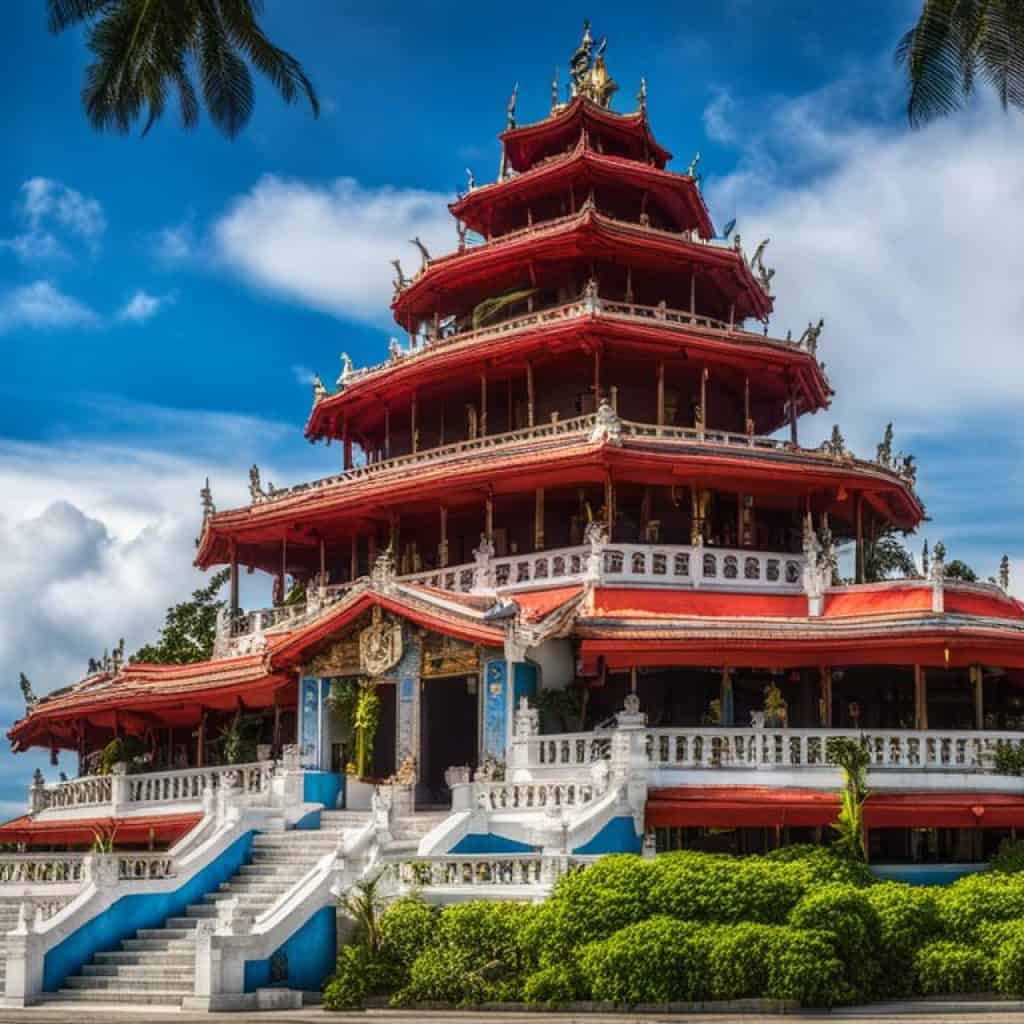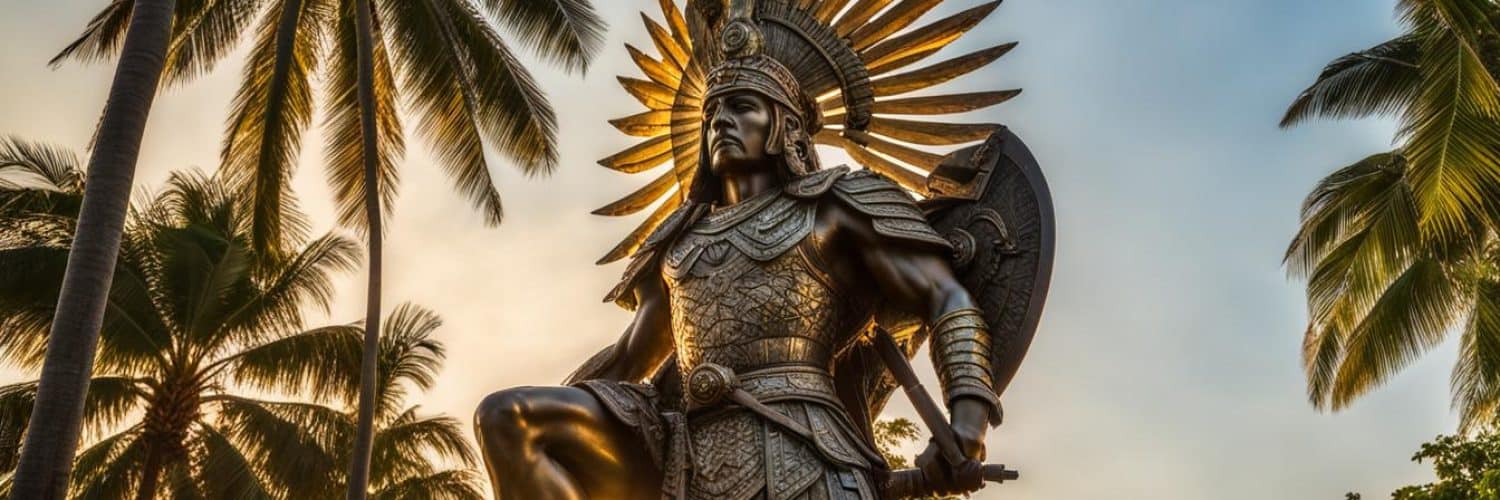Steeped in the rich tapestry of history, the Lapu-Lapu Shrine in Cebu Philippines stands as both a solemn historical landmark and a vibrant tourist attraction. This commendable site honors the valor of the Philippine hero, Lapu-Lapu, etching his legendary victory in the annals of time. Against the backdrop of Mactan Island’s tropical beauty, the monument resonates with the spirit of independence and legacy of a nation’s pride.
Encircled by the island’s stunning landscape, visitors from around the globe are drawn to the towering copper statue and the serene yet powerful atmosphere of the grounds. While the tranquillity of the vicinity captivates, the nearby commemorative mural brings to life the fateful day that marked a nation’s enduring resolve. For history enthusiasts and casual tourists alike, the shrine’s simplistic allure and educational significance make for a poignant visit amidst Cebu’s tropical charm.
Key Takeaways
- The Lapu-Lapu Shrine is a testament to Philippine history and resistance to colonization.
- Located on Mactan Island, the site is accessible and close to luxurious accommodations like the Shangri-La Hotel.
- A large copper statue of Lapu-Lapu serves as the centerpiece, symbolizing the triumph over European forces.
- The area is not just a historical site but also offers a spacious environment for reflection and education on Filipino heritage.
- Despite varying opinions on the site’s presentation, the shrine maintains a special place in the hearts of Filipinos and visitors alike.
- Close to the shrine are tourist trap shops, though they offer an eclectic mix of souvenirs and local craftsmanship.
Exploring the Historical Significance of Lapu-Lapu Shrine
The Lapu-Lapu Shrine isn’t merely a monument; it represents a pivotal chapter in the history of the Philippines. Situated on Mactan Island, the site honors a story of courage and determination that continues to resonate with Filipinos and history enthusiasts alike.
The symbol of Philippine Resistance
In recognition of the indomitable spirit of the Filipino people, the Lapu-Lapu Shrine stands as a powerful symbol of resistance. It acknowledges Lapu-Lapu, often celebrated as the first Philippine hero, who demonstrated an unwavering resolve to protect his land against foreign dominion.
The Battle of Mactan and Ferdinand Magellan
The historical significance of the Battle of Mactan is etched deeply into the annals of Philippine history. It was here that Ferdinand Magellan met his fate, an event that propelled Lapu-Lapu to the forefront of Philippine icons and marked a profound moment of national pride and defiance.
| Event | Significance | Annual Commemoration |
|---|---|---|
| Battle of Mactan (1521) | Led by Lapu-Lapu, the battle signifies the first successful resistance against European colonial forces. | Kadaugan sa Mactan |
| Statue Erection | The towering statue at the shrine serves as a reminder of the courage and leadership of Lapu-Lapu. | Year-round, with heightened festivities during Lapu-Lapu Day |
| Legacy of Ferdinand Magellan | Magellan’s downfall on Mactan Island remains a cautionary tale of the immense challenges faced by explorers during the era of world circumnavigation. | Reflected during historical talks and school curricula |
Lapu-Lapu Shrine, Cebu Philippines: A Must-Visit Destination
When setting foot on the storied soil of Cebu, one is struck by the blend of history and culture that emanates from its landmarks. Among these, the Lapu-Lapu Shrine is a towering figure, both literally and metaphorically. This site honors a heroic past while offering a serene setting for reflection and understanding. The legacy of the valorous Lapu-Lapu is immortalized here, making it a tourist spot with profound significance.
The shrine captures the imagination of visitors from around the globe, many of whom journey from countries as far as Portugal and Australia in search of historical connection and cultural experiences. As a must-visit destination in Cebu Philippines, the Lapu-Lapu Shrine is not merely a passive spectacle. It prompts an active engagement with the nation’s triumphant story against colonization.
- The spacious and orderly grounds provide a conducive environment for visitors to fully immerse themselves in the history of the Philippines.
- The detailed depiction of the Battle of Mactan at the shrine serves as a gateway to understanding Philippine independence and identity.
- Artifacts and information available at the site ensure even those unfamiliar with the narrative leave with a heightened appreciation for the country’s rich cultural heritage.
Encountering the Lapu-Lapu Shrine is more than a simple excursion; it is an essential experience for anyone who wishes to understand the heart and spirit of the Filipino people. Its inclusion in any travel itinerary exemplifies not only an appreciation for historical landmarks but also underscores the importance this monument holds as a symbol of pride for both local residents and the nation as a whole.
The Majestic Statue of Lapu-Lapu: A Tribute to the First Philippine Hero
As a towering figure in the Philippine narrative, the remarkable statue of Lapu-Lapu at the Lapu-Lapu Shrine stands sentinel on the island of Mactan. It is more than a mere structure; it’s a monumental tribute to the first Philippine hero who repelled foreign domination. This breathtaking icon not only dominates the skyline but also captures the essence of Philippine cultural heritage and national pride.
An Iconic Cultural Heritage Structure
At an impressive 20 meters tall, the bronze effigy of Lapu-Lapu has become a historical landmark synonymous with strength and perseverance. It’s an image that resonates with the ideals of freedom and defiance against colonial rule. This symbolic structure is a reminder of the valor shown by Lapu-Lapu and his warriors, serving as a source of inspiration to many who visit this sacred site.
The Art and Realism of the Monument
The realism ingrained in every detail of the statue transports visitors back to the time of early resistance against foreign forces. From the battle wear visible on the noble protector to the accurate representation of traditional attire, the artistry of the monument captivates onlookers. It’s a masterful rendition that allows you to feel the sea breeze that once lifted the spirits of a nation.
Visitors to the shrine can engage with this piece of history, brought vividly to life and enshrined in bronze. It represents the legacy of a revered Philippine hero and stands as a compelling invitation for those who seek to understand the profound depths of the country’s past.

Insights from Travelers: Reviews and Experiences
Traveler reviews of the Lapu-Lapu Shrine, a prominent tourist attraction in Cebu, Philippines, offer a kaleidoscope of impressions and insights. Visitors frequently share their experiences online, contributing to the shrine’s reputation as a significant historical site, while some opinions diverge, reflecting the broad spectrum of traveler expectations.
For many, a visit to the shrine is a pilgrimage to a pivotal location in Philippine history, the beach where Magellan met his defeat. Tourists often leave profound reviews speaking to the deep historical resonance they feel while standing on this hallowed ground:
“Walking along the same shorelines where a notable figure like Magellan fell was a powerful reminder of the Philippines’ rich history.”
Meanwhile, other visitors are drawn to the silent strength of the Lapu-Lapu statue, pondering the hero’s legacy through careful observation. This mixture of review content reveals the shrine’s ability to stir reflections on valor and memory among its visitors:
“The statue of Lapu-Lapu stands tall and silent, yet it speaks volumes about the courage of the Filipino people.”
The area surrounding the shrine also garners positive comments for its additional amenities, with travelers highlighting leisure activities, dining, and the vibrant local nightlife as enhancing the overall experience:
- Engaging restaurants offering local delicacies
- Lively bars and spots for evening recreation
- Proximity to other tourist attractions in Cebu
However, contrasting viewpoints emerge in some traveler reviews, which describe the shrine as less impactful than anticipated. Some question the veracity of the historical narrative portrayed, while others simply find the site less engaging than other attractions:
“Expecting a grand slice of history, I was surprised that the shrine felt more like a footnote – interesting, but not gripping.”
In the end, the varied testimonials underscore the subjective nature of travel and sightseeing. Each visitor comes away with a unique takeaway, be it a profound historical connection or an appreciation for the locale’s recreational offerings. Collectively, traveler reviews serve as a valuable barometer for those planning a visit to the Lapu-Lapu Shrine, offering a preview of the spectrum of experiences that await in the heart of Cebu, Philippines.
Preparing for Your Visit: Tips and General Information
Embarking on a journey to the historical Lapu-Lapu Shrine, a premier tourist spot in Cebu, Philippines, requires a bit of preparation to make the most of your experience. Here’s some valuable information to help you plan your visit effectively.
Best Time to Visit and Operational Hours
To fully appreciate the majesty of the Lapu-Lapu Shrine, timing is key. While the shrine exudes a tranquil aura throughout the day, arriving early can afford you the serene atmosphere of dawn, which is perfect for photography enthusiasts. Operational hours haven’t been officially set, but the site is generally accessible from early mornings to late evenings. Visiting during these times ensures you get to admire the shrine in different lighting conditions, enhancing your overall experience.
Amenities and Accessibility
The shrine is committed to providing a comfortable visit for all guests. Boasting various amenities such as ample parking space, clean restrooms, and a selection of nearby local eateries, visitors can ensure a day’s trip is as convenient as it is enlightening. Enhanced accessibility for differently-abled guests ensures everyone has the opportunity to pay homage to this significant historical monument.
| Tips for Visitors | Recommendations |
|---|---|
| Arrival Time | Early morning for fewer crowds |
| Night Visits | Unique perspective post-sunset |
| Entrance Fee | No fee, but caution with personal items suggested |
| Parking | Available, including for tour buses |
| Dining Options | Local food stalls and restaurants nearby |
| Accessibility | Facilities available for differently-abled visitors |
Adhering to these insights and leveraging the amenities available, your visit to the illustrious Lapu-Lapu Shrine is set to be a memorable expedition into the past. Cherish the opportunity to stand where history was made, and take away a piece of this monumental legacy.
Engaging with Cebu’s Rich Cultural Tapestry
When visitors step beyond the historical bounds of the Lapu-Lapu Shrine, they find themselves immersed in a world brimming with the cultural heritage of Cebu, Philippines. Each corner of this vibrant region offers a narrative that weaves together the threads of history, tradition, and modern sensibilities.
| Attraction | Cultural Significance | Experience Offered |
|---|---|---|
| Cebu Provincial Museum | The annals of the province’s rich past. | An in-depth exploration of Cebu’s historical narrative. |
| Taoist Temple | Integration of multicultural spiritual practices. | A tranquil visit with panoramic views and spiritual insight. |
| Resort Gardens | Luxury set amidst natural beauty. | Relaxation in settings that blend opulence and serenity. |
While the Lapu-Lapu Shrine represents the valor and spirit of the Philippine people’s ancestors, the other gems scattered throughout Cebu open doors to even wider perspectives. From solemn historical sites to luxurious natural spaces, visitors are encouraged to partake in Cebu’s rich cultural tapestry, forging connections with its living history and experiencing its contemporary evolution first-hand.
Engage with the tapestry of Cebu and discover how the past informs the present in the most vibrant of fashions.
The Festivities: Kadaugan sa Mactan Festival and Lapu-Lapu Day
Celebrating the valor of a nation’s hero, the Kadaugan sa Mactan Festival is a vibrant, annual event that captivates both locals and tourists with its spectacular portrayal of a historic battle. As the cornerstone of the event, the Lapu-Lapu Shrine becomes the backdrop against which the dramatic reenactment of the battle between native chieftain Lapu-Lapu and the Spanish explorer Ferdinand Magellan takes place. This momentous festival is not only a source of immense local pride but also attracts visitors from around the globe keen to witness the rich cultural heritage of the Philippines.
Underscoring the importance of this historical event, Lapu-Lapu Day is observed each year on April 27th. This public holiday is integral in promoting cultural identity and remembrance, reinforcing the heroism of Lapu-Lapu and his warriors. It is a time when the people of Cebu, and the Philippines at large, reflect on the bravery that shaped their nation’s destiny.
The festivities surrounding this significant day are marked by a series of events and attractions that include traditional dances, lively street fairs, and culinary feasts. Here’s what visitors can expect during these celebrations:
- Vibrant reenactment of the Battle of Mactan
- Street parades featuring colorful costumes and floats
- Traditional Filipino games and cultural performances
- Exhibitions showcasing Cebuano arts and crafts
- Gastronomic delights that offer a taste of local cuisine
Participation in the Kadaugan sa Mactan Festival and the observation of Lapu-Lapu Day provide a unique opportunity to immerse oneself in the spirit of the Philippines and discover the indomitable courage that is so deeply embedded in the fabric of its society.
A Walk Through History: The Battle of Mactan Reenactment
The Battle of Mactan, a cornerstone event in Philippines history, is vividly brought to life in a dramatic reenactment at the Lapu-Lapu Shrine, one of the Philippines’ prominent historical landmarks. Every stab and parry of this carefully choreographed performance illuminates the valor of the native warriors and the tragic demise of Ferdinand Magellan during that fateful encounter.
In this immersive experience, spectators find themselves captivated by the intensity of the reenactment. It serves as both an educational showcase and a remembrance of the resistance that shaped the nation. The event typically features local actors, donning traditional armor and weapons that mirror the combatants’ garb centuries ago, ensuring that every visitor walks away with a deeper appreciation of Philippine history and culture.
Below are some details describing what one can expect from the reenactment:
| Aspect of Reenactment | Details |
|---|---|
| Event Location | Lapu-Lapu Shrine, Mactan Island |
| Historical Focus | Depiction of the 1521 Battle of Mactan |
| Performers | Local actors and historical enthusiasts |
| Educational Value | High, provides insights on historical warfare and tactics |
| Audience | Students, tourists, history buffs |
| Interactive Element | Opportunities for audience participation in certain phases |
The annual staging of the reenactment aligns with a profound respect for the past, anchoring the present in the rich heritage of the Filipino people. The event is more than just a retelling; it’s an invitation to witness the pivotal moments that shape a nation’s collective memory, standing at the very place where history was made. Come and relive the valor at the Lapu-Lapu Shrine.
Nearby Attractions: Extending Your Journey Beyond the Shrine
Your cultural exploration doesn’t have to end with a visit to the esteemed Lapu-Lapu Shrine. Mactan Island, rich in historical tapestry, beckons with an array of historic landmarks and vibrant tourist spots waiting to be discovered. Venture beyond the shrine’s grounds to encounter a world where history and modernity intertwine seamlessly within the island’s dynamic surroundings.

Cebu’s Other Historic Landmarks and Tourist Spots
Embark on a journey through time as you visit Cebu’s cherished landmarks. Discover serenity at the Cebu Taoist Temple or marvel at the architectural majesty of the Temple of Leah. These sites not only enhance the island’s cultural narrative but also provide perfect backdrops for those seeking the beauty of classical structures juxtaposed with tropical charm.
Shopping and Dining Options around Mactan Island
For a taste of Cebu’s contemporary offerings, immerse yourself in the bustling atmosphere of SM Seaside City Cebu. Here, shopping enthusiasts and culinary adventurers alike can indulge in a wide array of shops and restaurants, delivering an all-encompassing experience that complements the historical journey.
| Attraction | Type | Experience |
|---|---|---|
| Cebu Taoist Temple | Cultural Site | A peaceful sanctuary offering a glimpse into Chinese religious practices within a local setting. |
| Temple of Leah | Architectural Wonder | An edifice of love that stands as a testament to timeless romance and classical design. |
| SM Seaside City Cebu | Lifestyle Mall | A premier shopping destination with a variety of retail, dining, and entertainment options. |
Whether you’re a history buff, a shopaholic, or a foodie, Mactan Island caters to all. Its blend of past and present ensures that each moment of your visit is both memorable and rich with opportunities. So, when your time at the Lapu-Lapu Shrine concludes, let your curiosity guide you through the island’s many other tourist spots and historic landmarks.
Conclusion
As the sun sets on our exploration of Mactan Island, the enduring spirit of the Lapu-Lapu Shrine stands sentinel in the collective memory of Cebu, Philippines. This historical landmark serves not merely as a sculpture set in stone but as an ongoing dialogue between past and present—a testament to the indomitable will of a nation. Visitors invariably leave with not just photographs, but with a profound sense of the weight of history and the stories pulsating through the ground upon which they stand.
Whether one is drawn by the allure of cultural significance, the vibrant reenactments of heroism, or simply as an aficionado of exceptional tourist attractions, the shrine encapsulates the essence of reverence and contemplation. The stark contrast of the simple grandeur against the bustling backdrop of Cebu’s life serves as a poignant reminder of the dynamic interplay between history and modernity.
As a focal point of patriotism and a beacon of heritage, the Lapu-Lapu Shrine remains not just a must-visit destination but an experiential voyage through time. Here, amidst the whispers of the past and the resonant pride of the Filipino people, the legacy of Lapu-Lapu continues to echo, inspiring all who come to reflect upon the hallowed grounds of Mactan Island.
FAQ
What is the Lapu-Lapu Shrine and why is it significant?
The Lapu-Lapu Shrine is a historical landmark located on Mactan Island in Cebu, Philippines. It is dedicated to the Filipino hero Lapu-Lapu and marks the site where the Battle of Mactan took place, wherein Lapu-Lapu and his warriors defeated the forces of Portuguese explorer Ferdinand Magellan.
Who was Lapu-Lapu?
Lapu-Lapu was a local chieftain of Mactan Island who is considered to be the Philippines’ first national hero. He is celebrated for his resistance against Spanish colonization and his victory over Ferdinand Magellan in the Battle of Mactan in 1521.
What does the statue at the Lapu-Lapu Shrine represent?
The statue at the Lapu-Lapu Shrine represents the heroism and bravery of Lapu-Lapu. It is a symbol of Philippine resistance to foreign invaders and serves as a tribute to the resilience and courage of the Filipino people.
Are there festivals or events associated with the Lapu-Lapu Shrine?
Yes, the Kadaugan sa Mactan Festival, which includes a reenactment of the Battle of Mactan, is an annual event celebrated at the shrine. Additionally, Lapu-Lapu Day is observed to honor the hero’s legacy.
Is there an entrance fee to visit the Lapu-Lapu Shrine?
No, there is no entrance fee required to visit the Lapu-Lapu Shrine. It is open to the public and is a popular tourist spot in Cebu, Philippines.
What are some other attractions near the Lapu-Lapu Shrine?
Near the Lapu-Lapu Shrine, visitors can explore other historical landmarks and tourist spots such as the Cebu Taoist Temple, the Temple of Leah, and SM Seaside City Cebu for shopping and dining options.
What is the best time to visit the shrine?
For photo opportunities, visitors often suggest arriving early in the morning around 6 AM. Visiting at night can also provide a different perspective as the tides recede. But the official operational hours of the shrine are not clearly stated.
Are there amenities available at the Lapu-Lapu Shrine?
The shrine offers a simple yet orderly environment with minimal facilities. As it is a historical site rather than a commercial establishment, amenities are limited. Visitors are encouraged to check nearby areas for restaurants, restrooms, and other needs.
How do I reach the Lapu-Lapu Shrine?
The Lapu-Lapu Shrine is easily accessible by taxi or local transport from various points within Cebu. It is located on Mactan Island, which is connected to the main island of Cebu by bridges.
What should I be aware of when visiting the shrine?
While visiting the Lapu-Lapu Shrine, it is advised to be aware of your surroundings and take care of your personal belongings. The site is a popular tourist attraction, so it is wise to stay vigilant against pickpocketing or other tourist-targeted crimes.











Add comment